From its humble beginnings as a practical tool for pilots to its iconic status as a symbol of luxury and precision, the Rolex GMT-Master has captured the hearts of watch enthusiasts worldwide. Initially designed in collaboration with Pan American Airways, the GMT-Master allowed pilots to track multiple time zones, making it an essential instrument for long-haul flights. Over the decades, it has evolved, incorporating technological advancements and design refinements that have solidified its place in the annals of horology.
In this comprehensive guide, we will delve into the world of the GMT-Master, exploring its rich history, highlighting its key features, and providing valuable insights for purchasing this iconic watch.
Whether you are a seasoned collector or a newcomer to the world of luxury timepieces, this guide will offer a detailed overview of the GMT-Master’s evolution, its notable models, and the distinguishing characteristics that make it a timeless masterpiece.
<>
<>
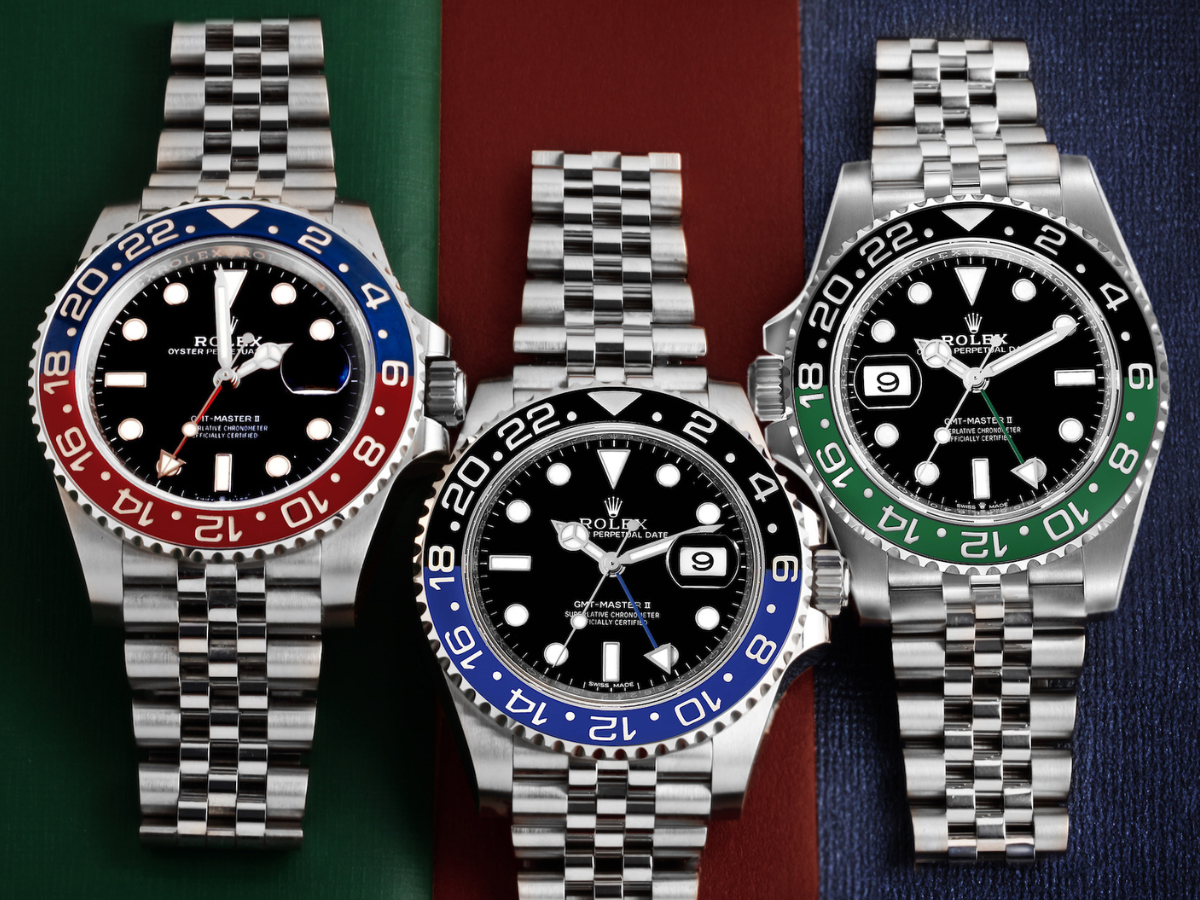
About the Rolex GMT-Master
The history of the Rolex GMT-Master is deeply rooted with the evolution of commercial and transcontinental flights in the mid-20th century. As air travel became increasingly popular, the demand for reliable timekeeping tools that could track multiple time zones became essential. This era marked the rise of global aviation giants such as Pan American World Airways (Pan Am), which required precise tools for their pilots to navigate long-haul flights across different time zones.
Before the GMT-Master’s creation, Rolex had already established a strong reputation for developing robust watches. Models like the Turn-O-Graph and Zerographe, introduced in the early 1950s, featured rotating bezels designed for timing elapsed minutes. These innovations laid the groundwork for Rolex’s subsequent development of the GMT-Master.
In the early 1950s, Pan Am approached Rolex with a specific request: to create a watch that could display multiple time zones simultaneously, a crucial feature for their pilots. This collaboration led to the creation of the Rolex GMT-Master, a timepiece that would not only meet the technical needs of pilots but also become an iconic watch beloved by enthusiasts worldwide.
<>
<>
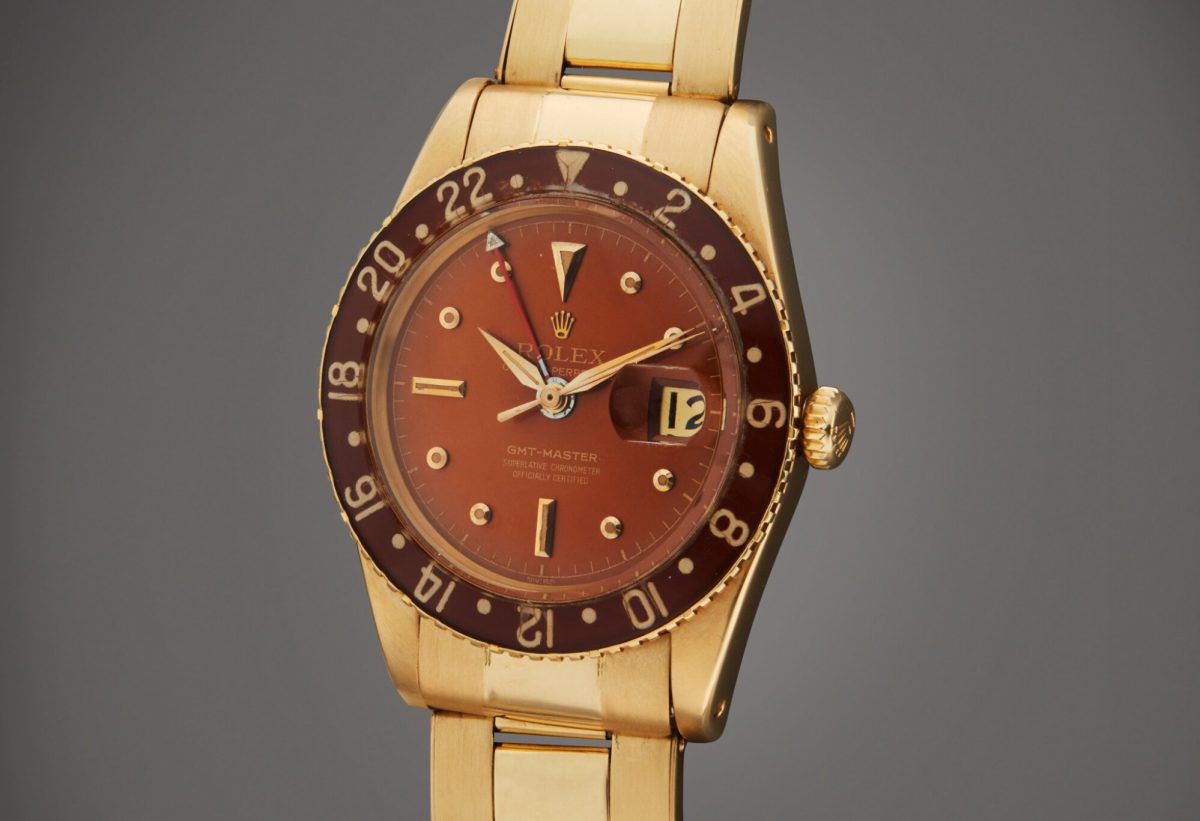
1954: The Birth of an Icon
The Rolex GMT-Master was officially introduced in 1954. The first model, Reference 6542, featured a 24-hour rotatable bezel and a fourth hand to indicate the second time zone. This design allowed pilots to easily track Greenwich Mean Time (GMT), essential for flight coordination across different time zones. The original bezel was made of Bakelite, which included radium-based lume for visibility in the dark. However, due to its fragility, the Bakelite bezel was later replaced with a more durable aluminum insert. Its unique design and functionality quickly made it a favorite among aviators and watch enthusiasts alike.
<>
<>
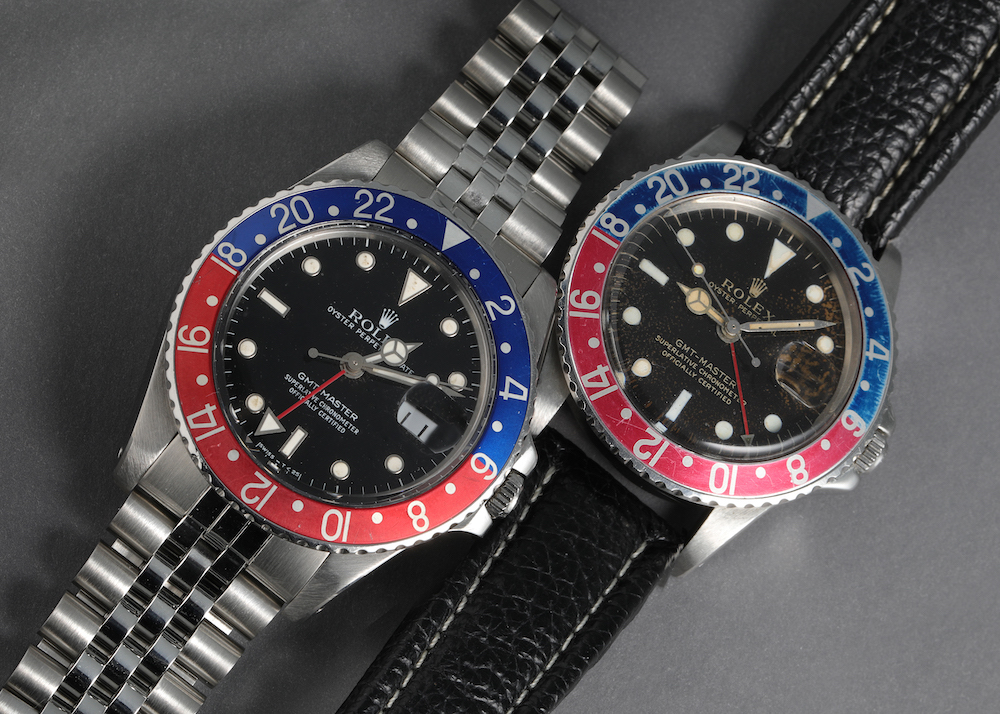
1955-1959: Early Advancements
During these formative years, the GMT-Master saw the introduction of various models such as the GMT-Master ref 6542, ref 1675, and the Caliber 1065. These models featured incremental improvements in design and functionality. The 1675, introduced in 1959, included crown guards and a more robust movement, making it a staple for pilots and watch enthusiasts alike. These models enhanced the watch’s durability and precision, solidifying its reputation as a reliable tool for professionals.
<>
1972: Precision with the Hack Feature
In 1972, the GMT-Master received a significant update with the addition of the “hack” feature. This allowed the seconds hand to be stopped when the crown was pulled out, enabling precise time synchronization. This enhancement was particularly useful for pilots and other professionals requiring exact timekeeping.
<>
<>

1981: The Quick-Set Date Function
The release of the GMT-Master 16750 in 1981 marked a significant upgrade with the introduction of the quick-set date function, powered by the Caliber 3075 movement. This feature allowed the date to be set independently of the main time, enhancing the watch’s convenience and functionality. The 16750 also doubled the water resistance of its predecessor, making it more versatile for different environments.
<>
<>

1982/83: The Introduction of the GMT-Master II
The early 1980s saw the debut of the GMT-Master II (ref 16760). This model introduced the new Caliber 3085 movement, which allowed the GMT hand to be adjusted independently from the main hour hand. This feature enabled users to track three time zones simultaneously, a significant enhancement over the original GMT-Master. It featured a distinctive red and black bezel, earning it the nickname “Coca-Cola” or “Coke.”
<>
<>
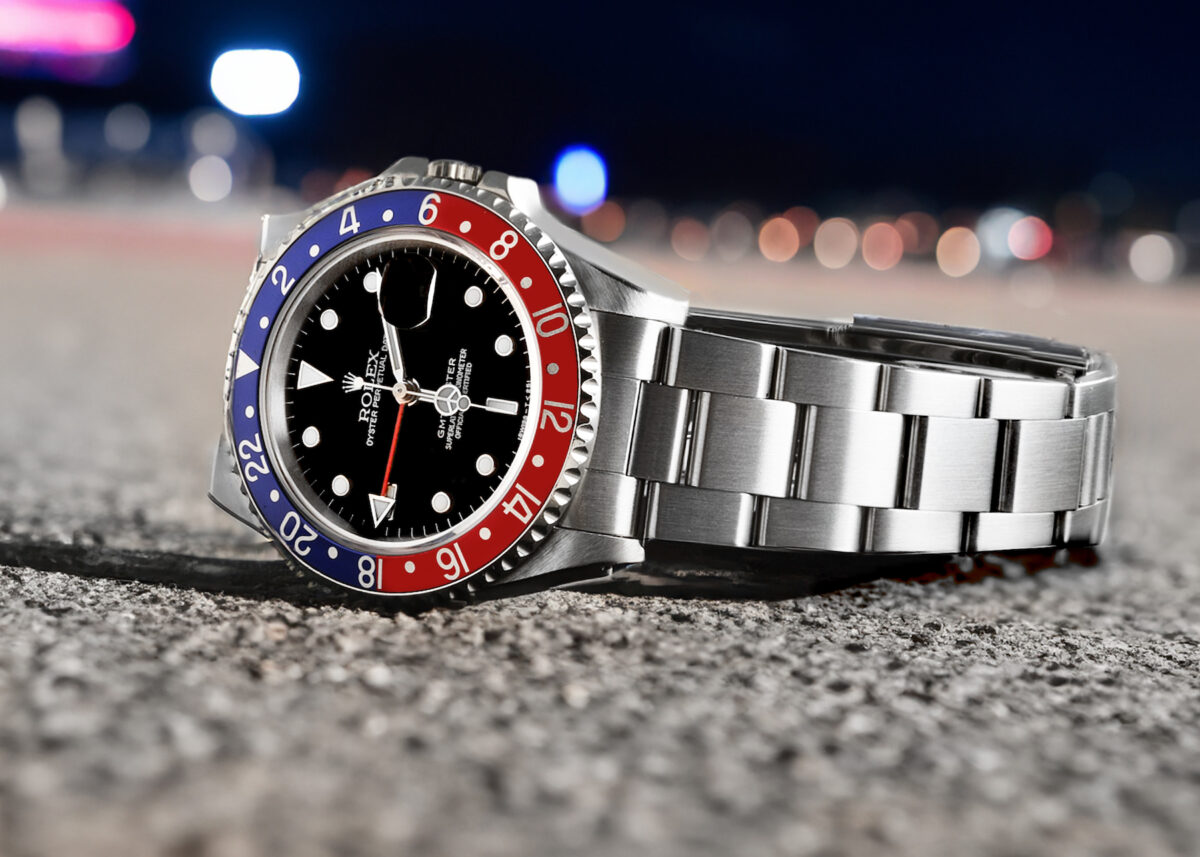
1988: The End of an Era
The production of the GMT-Master 16700 in 1988 marked the end of the original GMT-Master line. This model featured a sapphire crystal and the Caliber 3175 movement. It was produced alongside the GMT-Master II models until 1999, after which Rolex focused exclusively on the GMT-Master II line. The 16700 provided a more affordable alternative while maintaining the essential features that made the GMT-Master a favorite among professionals and enthusiasts. Its discontinuation left the GMT-Master II as the sole representative of this iconic line.
<>
Evolution from Rolex GMT-Master to GMT-Master II
The introduction of the Rolex GMT-Master II in 1983 marked a significant evolution in the GMT-Master series, addressing the growing demands of frequent travelers and professional aviators. The primary innovation of the GMT-Master II was the de-coupled hour hands, which allowed the 12-hour hand to be set independently from the 24-hour GMT hand. This advancement enabled users to track three time zones simultaneously: one with the local hour hand, another with the GMT hand, and a third by rotating the bezel.
While the GMT-Master could display two time zones by rotating the bezel to align with the 24-hour hand, the GMT-Master II offered enhanced functionality by allowing the hour hands to move independently. This meant that the local time could be adjusted without disturbing the GMT hand’s position, making it much easier to switch between time zones. This feature was particularly beneficial for pilots and travelers who needed to keep track of multiple time zones simultaneously.
<>
<>

1983: The Fat Lady
The first GMT-Master II model was the Reference 16760, also known as the “Fat Lady” due to its thicker case. This model introduced the Caliber 3085 movement, which allowed for the independent adjustment of the GMT hand. It also featured a sapphire crystal and white gold surrounds for the hour markers.
<>
<>
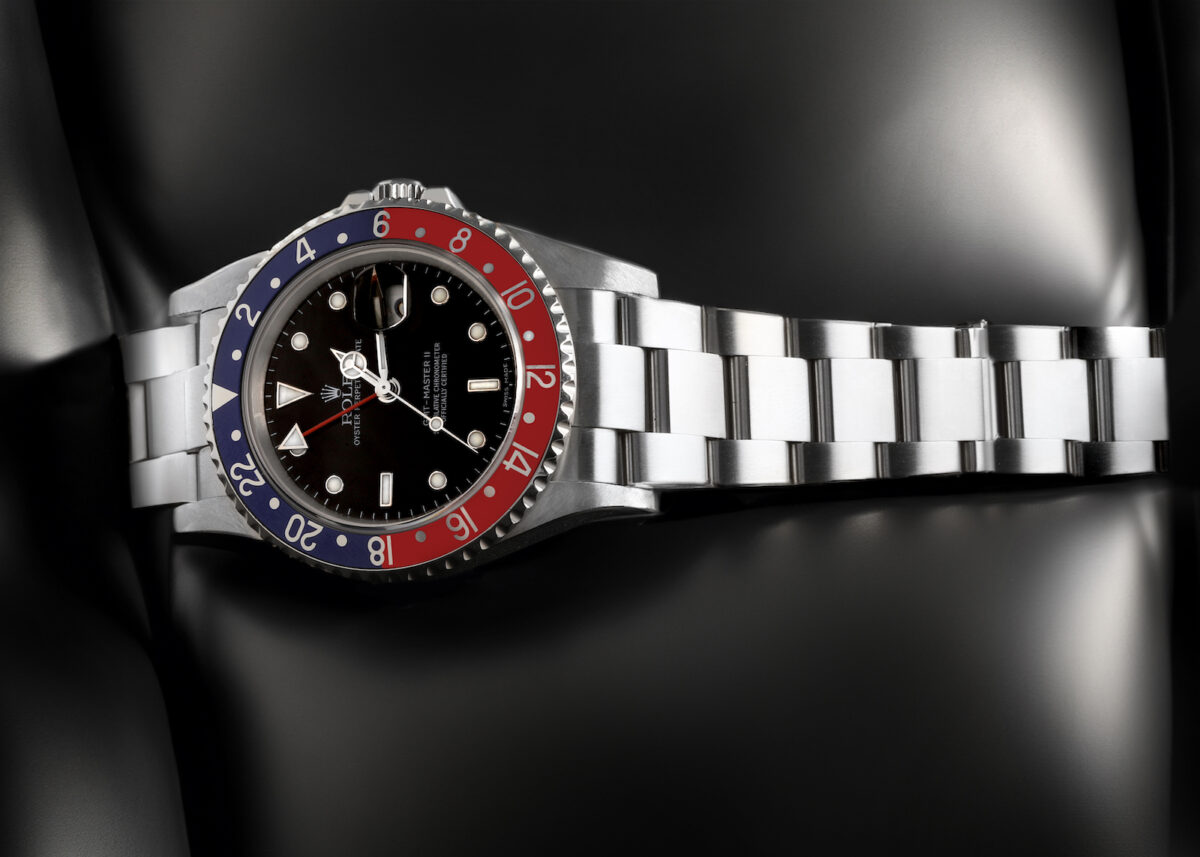
1989: Enhanced Water Resistance
In 1989, the second generation GMT-Master II 16710 was introduced, featuring an updated movement and a Triplock crown for improved water resistance. This model ran alongside the updated GMT-Master 16700, which had the updated sapphire crystal, white gold markers, and new movement but lacked the independent GMT hand. The 16710 remained in production until 2007.
<>
<>

2005: A Touch of Luxury
In 2005, Rolex celebrated the 50th anniversary of the GMT-Master by introducing the GMT-Master II Reference 116718 in 18k yellow gold. This model marked the debut of the Cerachrom bezel insert, a proprietary ceramic material developed by Rolex. The Cerachrom bezel is known for its scratch-resistant and fade-proof properties, offering enhanced durability and aesthetics compared to the previously used aluminum bezels. This innovation not only improved the watch’s functionality but also elevated its luxurious appeal, making it a coveted item among GMT-Master enthusiasts.
<>
<>

2007: The Ceramic Revolution
The introduction of the first steel model with Cerachrom inserts came in 2007 with the Reference 116710LN. This model replaced the aluminum bezel inserts with the new ceramic ones, providing enhanced scratch resistance and longevity. The ceramic bezel maintained its vibrant color and pristine condition over time, significantly reducing the wear and tear that aluminum bezels typically suffered. This model also featured a Maxi dial with larger hands and markers, improving legibility. A yellow gold model with a black dial and two-tone model followed soon after.
<>
<>
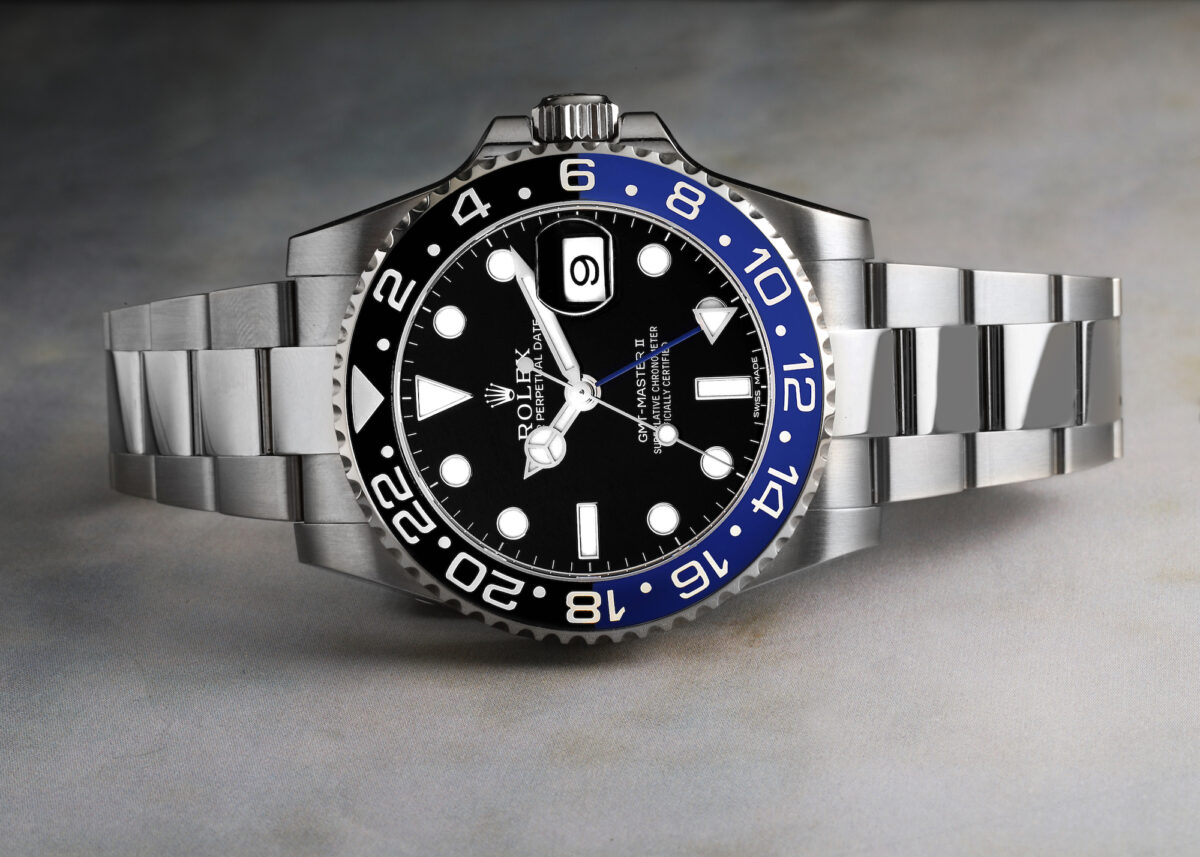
2013: The Batman
In 2013, Rolex introduced its first two-color bezel insert in Cerachrom with the GMT-Master II Reference 116710BLNR. This model featured a distinctive blue and black bezel, earning it the nickname “Batman” among collectors. The combination of two colors on a single piece of ceramic was a significant technical achievement, showcasing Rolex’s innovative prowess. The Batman quickly became an instant favorite due to its unique look and the advanced technology it represented.
<>
<>

2014: The White Gold Pepsi
Continuing its tradition of innovation, Rolex released the GMT-Master II Reference 116719BLRO in 2014. This model was crafted from 18k white gold and featured the iconic blue and red “Pepsi” bezel, now made from Cerachrom. This release was a testament to Rolex’s commitment to blending luxury with cutting-edge technology. The white gold Pepsi GMT-Master II combined the nostalgic appeal of the classic Pepsi bezel with the modern advancements of Cerachrom, making it a highly sought-after timepiece.
<>
<>

2018: New Movements and Materials
The introduction of the new Caliber 3285 movement in 2018 brought significant improvements, including a 70-hour power reserve. To house the new movement, Rolex rolled out several new GMT-Master II references:
126710BLRO: Featuring a blue / red “Pepsi” bezel and a Jubilee bracelet, this model combined the classic design with modern enhancements.
126715CHNR: Crafted in Everose gold with a brown/black bezel, this model offered a sophisticated and luxurious option.
126711CHNR: A two-tone model in Oystersteel and Everose gold with a brown/black bezel, blending elegance and durability.
126719BLRO: Featuring a blue/red bezel and crafted in white gold, this model represented the pinnacle of luxury and functionality in the GMT-Master II line
<>
<>
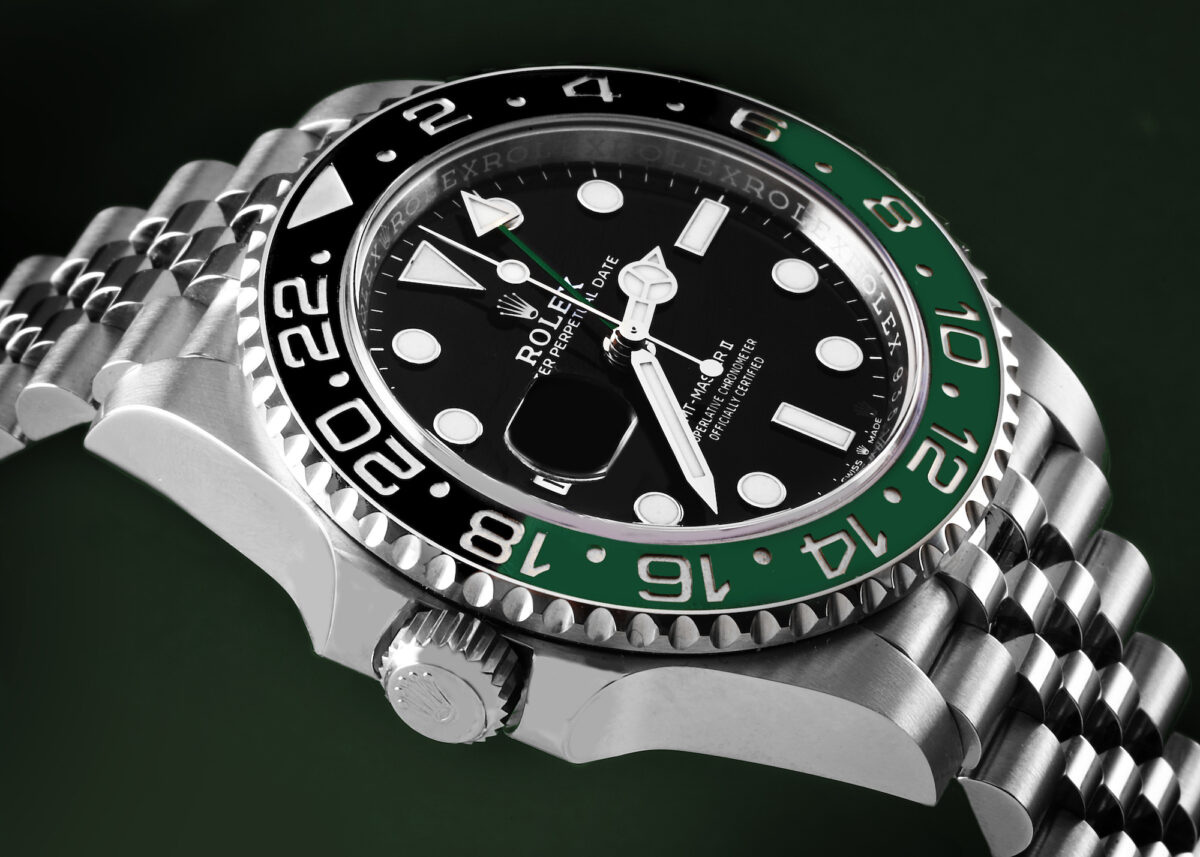
2022: The Sprite
In 2022, Rolex introduced the first GMT-Master II aimed at left-handed wearers. The “Sprite,” Reference 126720VTNR, featured a green and black bezel, adding a new color combination to the lineup. This model not only catered to left-handed users but also expanded the aesthetic options within the GMT-Master II series.
<>
<>

2023: The Zombie
Rolex brought back the two-tone GMT-Master II in 2023 with the “Zombie” Reference 126713GRNR. This model featured a Jubilee bracelet and a new gray-and-black bicolor bezel made of high-tech ceramic, offering a fresh and modern look while maintaining the durability and elegance expected from Rolex.
<>
<>

2024: The Bruce Wayne
In 2024, Rolex introduced two new GMT-Master II models in Oystersteel cases, both featuring a new gray-and-black bicolor bezel. The Reference 26710GRNR, dubbed the “Bruce Wayne,” comes in both Oyster and Jubilee bracelet options, showcasing the brand’s continuous innovation and commitment to providing versatile and stylish timepieces.
<>
Differences Between the GMT-Master and GMT-Master II
The Rolex GMT-Master and GMT-Master II series have several key differences, particularly in functionality and design. These distinctions have evolved over the years to meet the needs of travelers and watch enthusiasts alike.
<>
<>
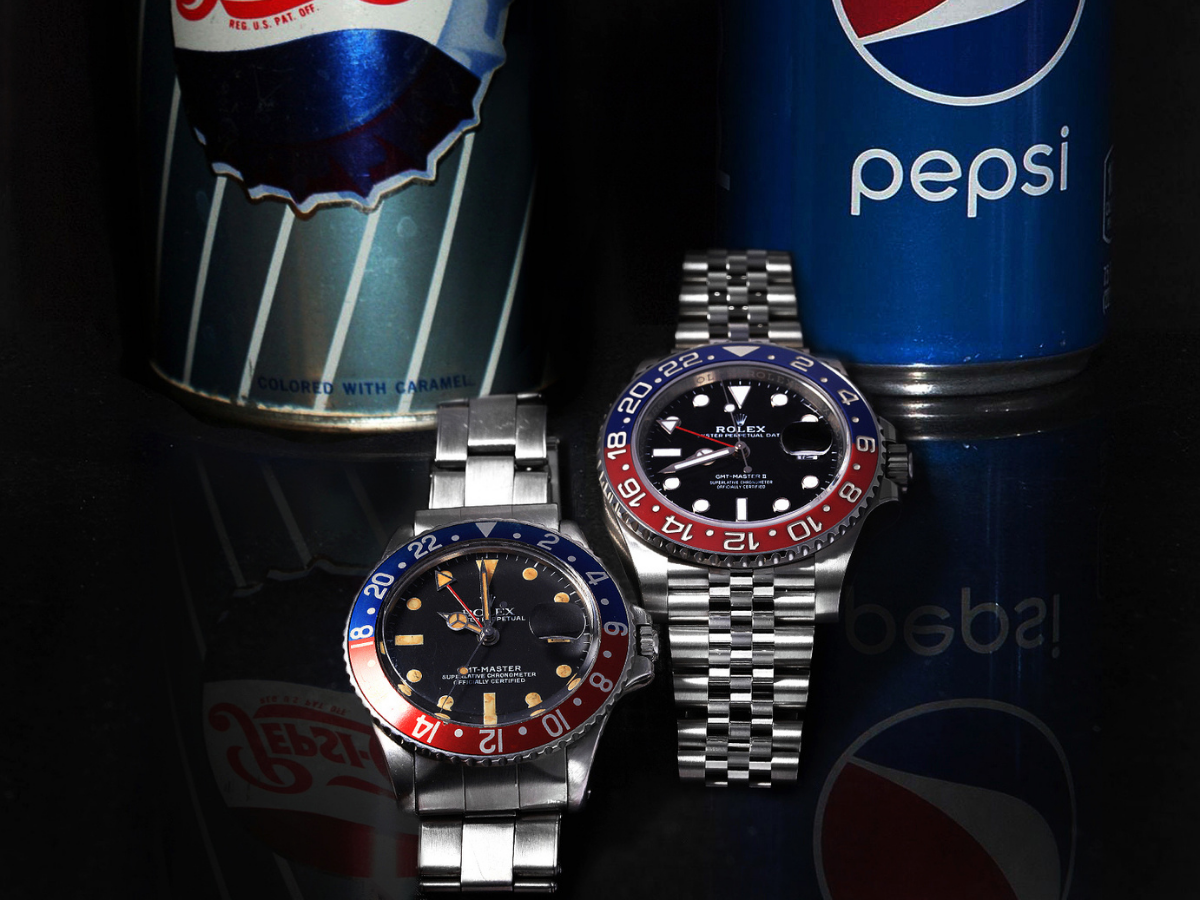
Functionality
The original GMT-Master was revolutionary for its time, allowing users to track two time zones simultaneously. This was achieved through a 24-hour hand and a rotating bezel that could be adjusted to reflect a second time zone. This functionality was particularly useful for pilots and frequent travelers who needed to keep track of their home and destination times.
The GMT-Master II took this functionality a step further by introducing the independent GMT hand. This allowed the 24-hour hand to be set separately from the main hour hand, enabling users to track three time zones simultaneously: local time with the main hands, a second time zone with the GMT hand, and a third time zone by rotating the bezel. This innovation significantly enhanced the watch’s versatility and made it a more powerful tool for global travelers.
<>
<>
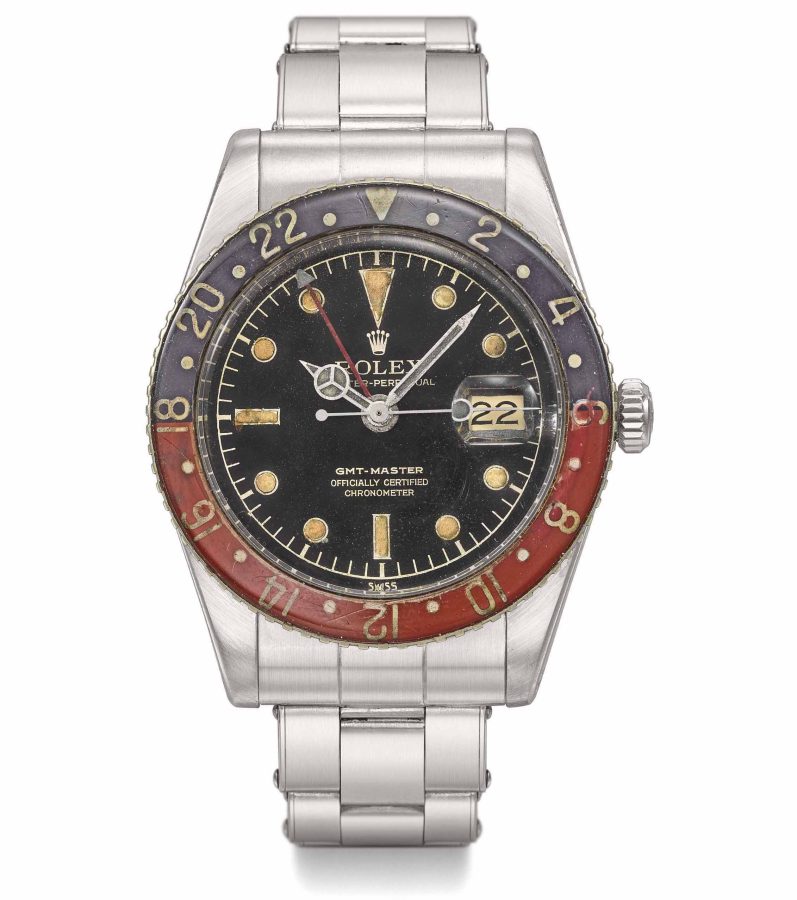
Design and Materials
GMT-Master:
Case and Bezel Materials: Available in stainless steel, two-tone yellow gold and stainless steel, and full yellow gold. Early models featured Bakelite bezels, which were later replaced by aluminum
Bezel Options: Various bezel color options, including black, blue (Blueberry), blue and red (Pepsi), and brown and beige (Root Beer)
Bracelet Options: Offered with both Oyster and Jubilee bracelets.
Luminous Materials: Early models used Radium, which was later replaced by Tritium, and eventually Luminova
Water Resistance: Initially 50 meters, increased to 100 meters in later models.
Crystal: Early models had acrylic crystals, with later models featuring sapphire crystals
<>
<>

GMT-Master II:
Case and Bezel Materials: Available in stainless steel, Yellow Rolesor (yellow gold and stainless steel), Everose Rolesor (Everose gold and stainless steel), solid white gold, solid yellow gold, and solid Everose gold
Bezel Options: Early models featured aluminum bezels, with Cerachrom ceramic bezels introduced from 2007 onwards. Current models offer a variety of two-tone bezel options, including blue and red (Pepsi), black and blue (Batman), brown and black (Root Beer), and black and red (Coke)
Bracelet Options: Comes with both Oyster and Jubilee bracelets, with some models also available with gem-set Serti dials and bezels in luxury versions
Luminous Materials: Used Tritium initially, followed by Luminova, Superluminova, and most recently, Chromalight, which emits a long-lasting blue glow
Water Resistance: All models are water-resistant to 100 meters
Crystal: All models feature sapphire crystals
<>
Most Notable GMT-Master and GMT-Master II References
Throughout the years, both the GMT-Master and the GMT-Master II have seen numerous references, each with its unique attributes, color schemes, and technological advancements, making them highly sought after by collectors and enthusiasts. Some of these references have gained iconic status due to their rarity, historical significance, or their place in popular culture.
<>
<>

Reference 6542 (1955-1959)
The Rolex GMT-Master Reference 6542, introduced in 1955, was designed specifically for Pan American Airways pilots to assist them with tracking multiple time zones on transcontinental flights. This model featured a distinctive red and blue Bakelite bezel, which became known as the “Pepsi” bezel, providing an intuitive day and night indication.
However, the Bakelite material was prone to cracking, and made use of radioactive material (radium) for its luminescence. This led Rolex to replace it with a safer and more durable aluminum insert in 1956.

The ref 6542’s 38mm case lacked crown guards, a feature that would be added in later models to protect the winding crown from damage. Inside, the watch housed three different calibers over its production run: Caliber 1036, Caliber 1065, and Caliber 1066, all of which were automatic movements that powered the time, date, and 24-hour hand.
The reference 6542 is also famously known as the “Pussy Galore” due to its appearance in the James Bond film “Goldfinger.” Its short production run and unique features make it a highly collectible and iconic timepiece in Rolex’s history.
<>
<>

Reference 1675 (1959-1980)
The Rolex GMT-Master Reference 1675, introduced in 1959, is one of the most iconic and recognizable models in the GMT-Master series. This reference marked the introduction of crown guards, which provided additional protection for the winding crown.
The 1675 was available in various bezel and dial combinations, including the classic “Pepsi” bezel, and was the first to feature the now standard 40mm case size. This model also saw the transition from Radium to Tritium for luminescence, improving safety and durability.

The 1675 initially housed the Caliber 1565, later updated to the Caliber 1575 in the late 1960s, which included a hacking feature for precise time-setting. Collectors highly value the early “exclamation point” dials, marked with a small dot below the 6 o’clock index to indicate reduced radium levels. The Reference 1675 was produced for over two decades, making it a staple in Rolex’s lineup and a favorite among vintage watch enthusiasts.
<>
<>

Reference 1675/3 (1970-1980)
The Rolex GMT-Master Reference 1675/3, introduced in 1970, is a distinguished two-tone variant of the iconic 1675. This model uniquely combines stainless steel with 18k yellow gold, resulting in a watch that exudes both robustness and luxury. The 1675/3 is particularly noted for its distinctive “Root Beer” aesthetic, featuring a rich brown dial with gold accents and a matching black and gold bezel. This dial, often referred to as the “nipple dial” due to its raised gold hour markers, adds to the watch’s unique character.
Under the hood, the 1675/3 is powered by the Caliber 1575 movement, an automatic chronometer movement that includes a GMT function and a date complication. While it did not feature the quick-set date function introduced in later models like the 16753, it offered reliability and precision, making it a popular choice among both professionals and watch enthusiasts.

The two-tone design of the 1675/3, coupled with its robust construction, made it appealing to those who wanted a timepiece that could transition seamlessly from a professional setting to a more casual or luxurious environment. The combination of precious metals and the unique color scheme provided a touch of opulence to the GMT-Master line, enhancing its desirability and collectability.
Over its decade-long production run, the 1675/3 saw variations in dial and bezel designs, contributing to its rich history and appeal among collectors. Today, the Reference 1675/3 remains a celebrated model for its distinctive aesthetics and the perfect blend of style and functionality.
<>
<>

Reference 16750 (1980-1988)
The Rolex GMT-Master Reference 16750, introduced around 1980, brought significant advancements to the GMT-Master series, positioning itself as a transitional model between vintage and modern Rolex watches. One of the most notable upgrades was the introduction of the Caliber 3075 movement, which offered a quick-set date function.
This innovation allowed users to set the date independently of the main time, significantly enhancing convenience. The Caliber 3075 also increased the movement’s frequency to 28,800 vibrations per hour (vph) compared to the previous 19,800 vph, improving accuracy and reliability.
Another major improvement was the enhanced water resistance. The 16750 doubled the depth rating from 50 meters to 100 meters, making it more durable and versatile for various conditions. This reference also marked the transition from acrylic crystals to sapphire crystals in subsequent models, although the 16750 itself retained the acrylic crystal.

During its production run, the 16750 featured two main dial variations. Early models came with matte black dials and painted tritium hour markers, while later versions transitioned to glossy dials with white gold surrounds, adding a touch of elegance and improving legibility. This change in dial design also gave rise to the rare and collectible “Spider dials,” known for their unique cracked lacquer appearance due to a manufacturing defect.
The bezel options for the 16750 included the iconic red and blue “Pepsi” bezel and a more subdued all-black bezel. The watch was available with both Oyster and Jubilee bracelets, providing versatility in style and wearability.
Overall, the 16750 retained the classic design elements of its predecessors while incorporating modern advancements, making it a highly sought-after model among collectors for its blend of vintage charm and contemporary functionality.
<>
<>
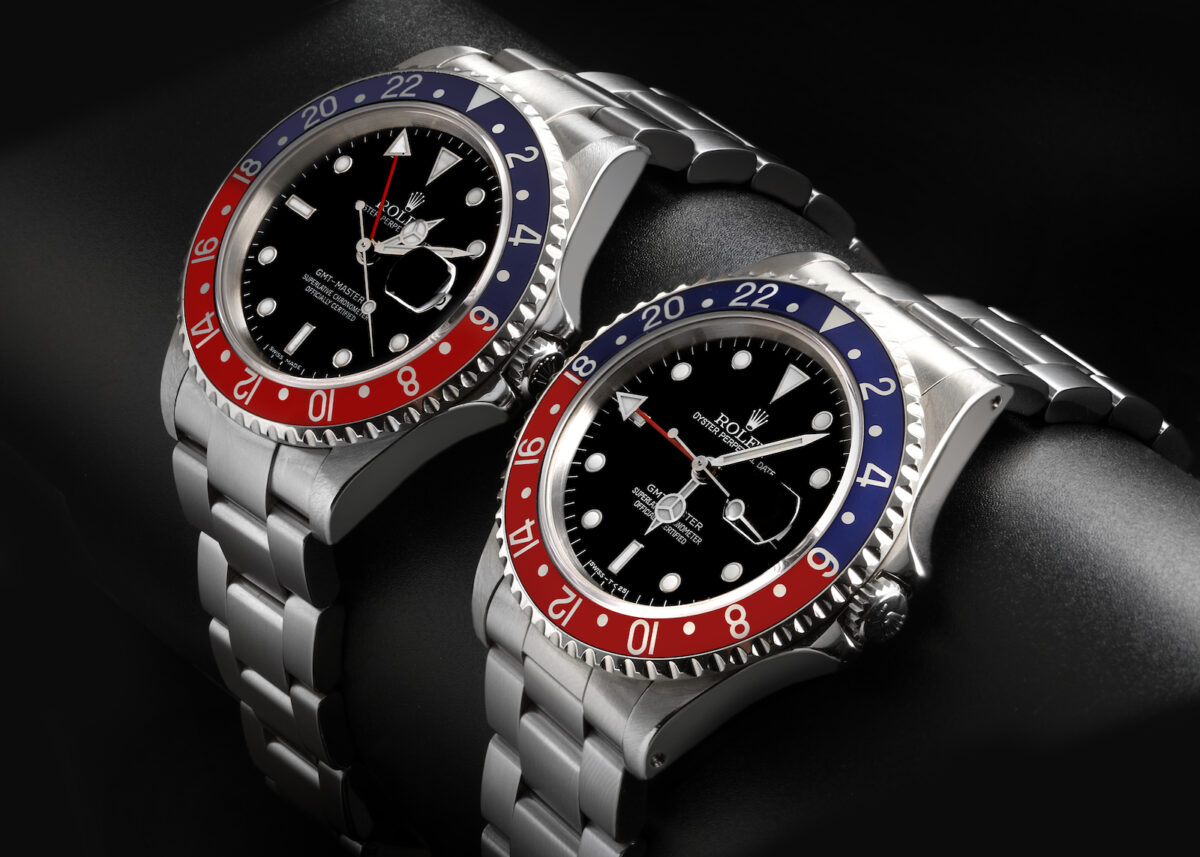
Reference 16700 (1988-1999)
The Rolex GMT-Master Reference 16700, produced from 1988 to 1999, was the final model in the original GMT-Master line before the series was fully succeeded by the GMT-Master II.
This reference featured a sapphire crystal and the Caliber 3175 movement, which retained the traditional non-independent GMT hand setup. The 16700 offered a more affordable alternative to the GMT-Master II while still providing essential features like the date function and the iconic rotating bezel.
This model also marked the transition from Tritium to Luminova for luminescence in 1997, enhancing its long-term legibility and safety. The Reference 16700 ran concurrently with the early GMT-Master II models, appealing to those who preferred the classic GMT-Master functionality and design.
<>
<>
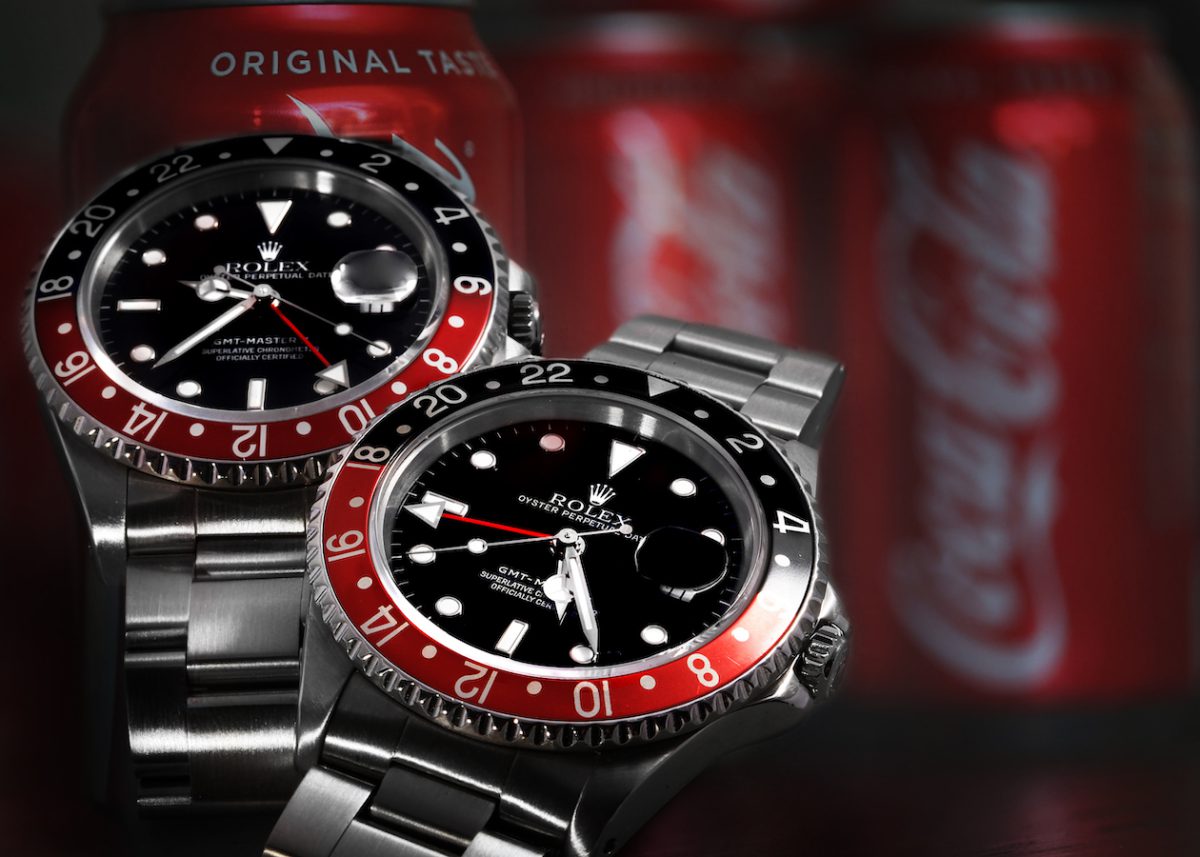
Reference 16760 (1982-1988)
The Rolex GMT-Master II Reference 16760, introduced in 1983, was the first model in the GMT-Master II series and brought several significant innovations to Rolex’s lineup. Known as the “Fat Lady” due to its thicker case, this design was necessary to house the new Caliber 3085 movement, which allowed the 24-hour hand to be set independently of the main hour hand. This feature enabled the tracking of three time zones, a revolutionary development for frequent travelers.
The 16760 featured a red and black bezel, known as the “Coke” bezel, a first for the GMT-Master line. The watch also marked the introduction of several modern features, including a scratch-resistant sapphire crystal and white gold surrounds on the hour markers to prevent tarnishing. It was exclusively available in stainless steel, with no precious metal variants, and could be paired with either the Oyster or Jubilee bracelet. Despite its relatively short production run, ending in 1988, the 16760 set a new standard for the GMT-Master series and remains highly collectible due to its numerous firsts and unique attributes.
<>
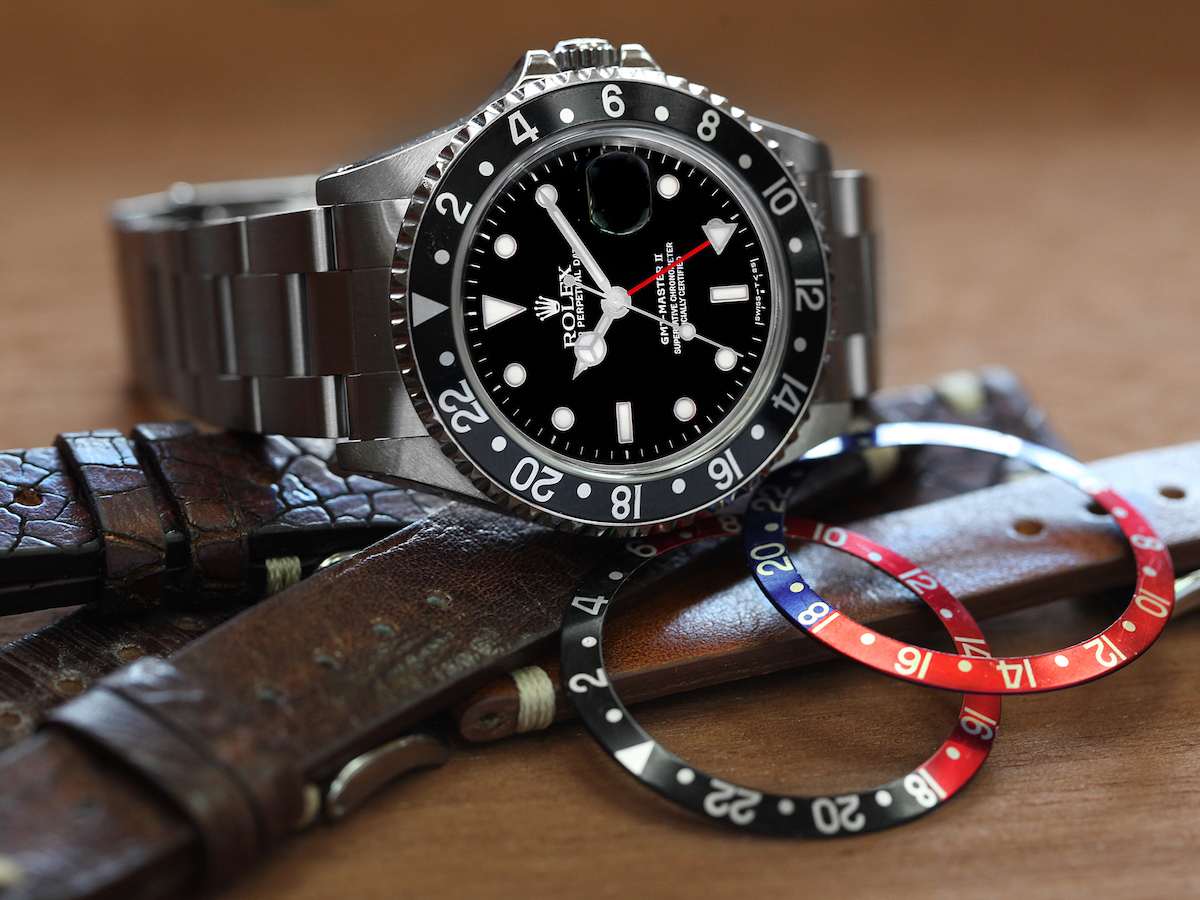
Reference 16710 (1989-2007)
The Rolex GMT-Master II Reference 16710, launched in 1989, is renowned for its blend of classic design and modern functionality. This model succeeded the GMT-Master II 16760 and featured the slimmer Caliber 3185 movement, later updated to the Caliber 3186. These movements allowed for the independent adjustment of the 24-hour GMT hand, a hallmark of the GMT-Master II series, enabling wearers to track three time zones simultaneously. The 16710 also introduced the Triplock crown, enhancing water resistance up to 100 meters.
One of the most distinctive features of the 16710 is its bezel options. Rolex offered this model with the iconic red and blue “Pepsi” bezel, the red and black “Coke” bezel, and an all-black bezel. This variety allowed for greater customization and appealed to a wide range of tastes. The watch was available with both Oyster and Jubilee bracelets, further adding to its versatility.

Throughout its production run, the 16710 underwent several updates. Early models used tritium for luminescence, marked with “T<25” on the dial, which was later replaced by Luminova in 1998 and then Super-LumiNova in 2000. Another significant update was the transition from drilled lug holes to solid end-links and a no-holes case design in 2003, enhancing the watch’s robustness and modern appeal.
The Reference 16710 was produced until 2007, marking the end of the pre-ceramic GMT-Master era. It remains highly sought after by collectors for its historical significance, versatile design, and the nostalgic charm of its aluminum bezel inserts.
<>
<>
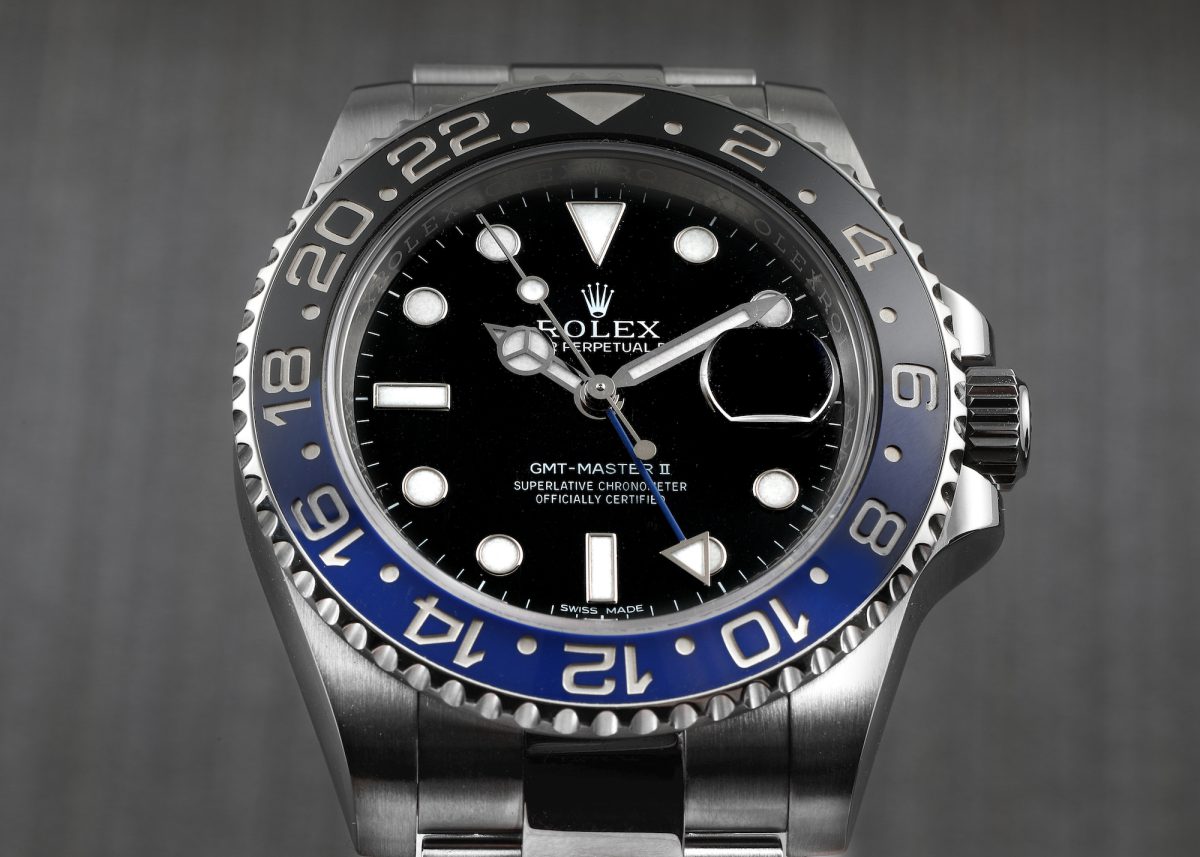
Reference 116710 / 116710 BLNR (2007-2019)
The Rolex GMT-Master II Reference 116710, introduced in 2007, marked a significant advancement in the GMT-Master series, heralding the era of Cerachrom bezels. The 116710LN featured a black Cerachrom ceramic bezel that was highly resistant to scratches and UV rays, ensuring it maintained its color and pristine condition over time. This material was a substantial improvement over the previously used aluminum bezels, which were prone to fading and scratches.

Powered by the Caliber 3186 movement, the 116710 included Rolex’s proprietary Parachrom hairspring, which offered enhanced accuracy and resistance to shocks and temperature variations. This movement was an evolution of the earlier Caliber 3185, featuring improved reliability and precision. The watch also introduced the Maxi dial, with larger hour markers and hands for improved legibility, and a Triplock crown for enhanced water resistance up to 100 meters.
In 2013, Rolex expanded the 116710 line with the introduction of the 116710BLNR, known as the “Batman,” which featured a distinctive blue and black Cerachrom bezel. This model quickly became a favorite among collectors due to its unique color scheme and modern advancements. The 116710 series offered both Oyster and Jubilee bracelet options, adding versatility and appeal. The references 116710LN and 116710BLNR remained in production until 2019, solidifying their status as highly desirable models in the GMT-Master II lineup.
<>
<>

Reference 126715 CHNR (2018 – present)
The Rolex GMT-Master II Reference 126715 CHNR, introduced in 2018, is a remarkable fusion of luxury and advanced watchmaking technology. This model is crafted entirely from Everose gold, Rolex’s proprietary rose gold alloy, which includes a small amount of platinum to ensure its durability and resistance to fading. The watch features a unique black and brown Cerachrom bezel, affectionately known as the “Root Beer” bezel, which provides a sophisticated and vintage-inspired look.
Powered by the Caliber 3285 movement, the 126715 CHNR offers a 70-hour power reserve and exceptional precision. This movement includes Rolex’s patented Chronergy escapement and Parachrom hairspring, enhancing its reliability and resistance to shocks and magnetic fields. The watch also boasts a Chromalight display, which provides long-lasting blue luminescence for excellent legibility in low-light conditions.

The 40mm case of the 126715 CHNR is water-resistant to 100 meters, thanks to its robust Oyster construction and Triplock crown. The watch is paired with an Everose gold Oyster bracelet, featuring a folding Oysterlock safety clasp and Easylink comfort extension link, ensuring both security and comfort.
This reference is a testament to Rolex’s continuous innovation and dedication to blending functionality with elegance, making it a standout choice for those seeking both style and performance in a high-end timepiece
<>
<>
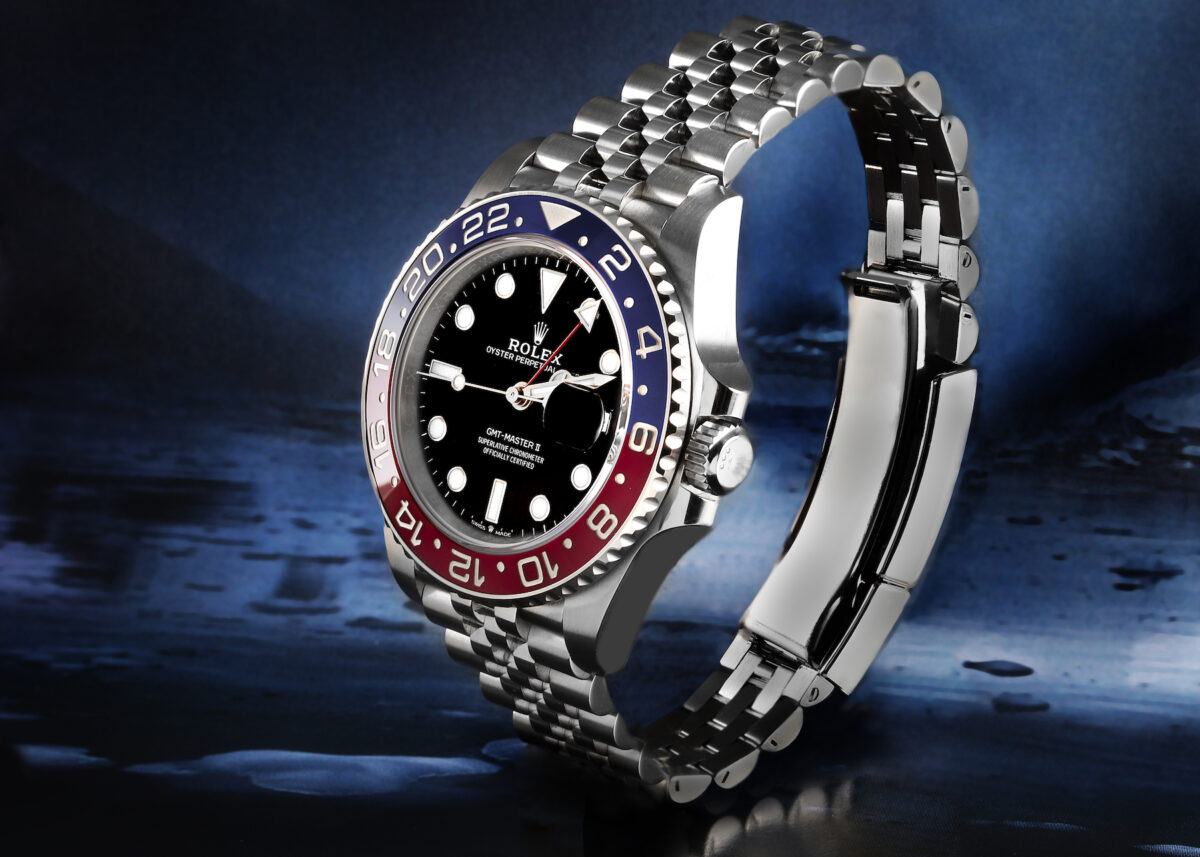
Reference 126710 BLRO (2018-Present)
The Rolex GMT-Master II Reference 126710 BLRO, introduced in 2018, brought back the iconic blue and red “Pepsi” bezel, now made from Cerachrom. This model features the Caliber 3285 movement, which provides a 70-hour power reserve and enhanced performance. The 126710 BLRO is available with a Jubilee bracelet, offering a blend of tradition and modernity. The use of Cerachrom for the bezel ensures it is highly resistant to scratches and maintains its vibrant color over time.
The combination of the classic “Pepsi” bezel with modern materials and technology makes the 126710 BLRO a highly sought-after model among collectors and enthusiasts alike. The Jubilee bracelet adds a touch of elegance, while the advanced movement ensures the watch performs to the highest standards. The 126710 BLRO represents a perfect fusion of Rolex’s historical design elements with contemporary watchmaking advancements, making it a standout piece in the current GMT-Master II collection.
<>
<>
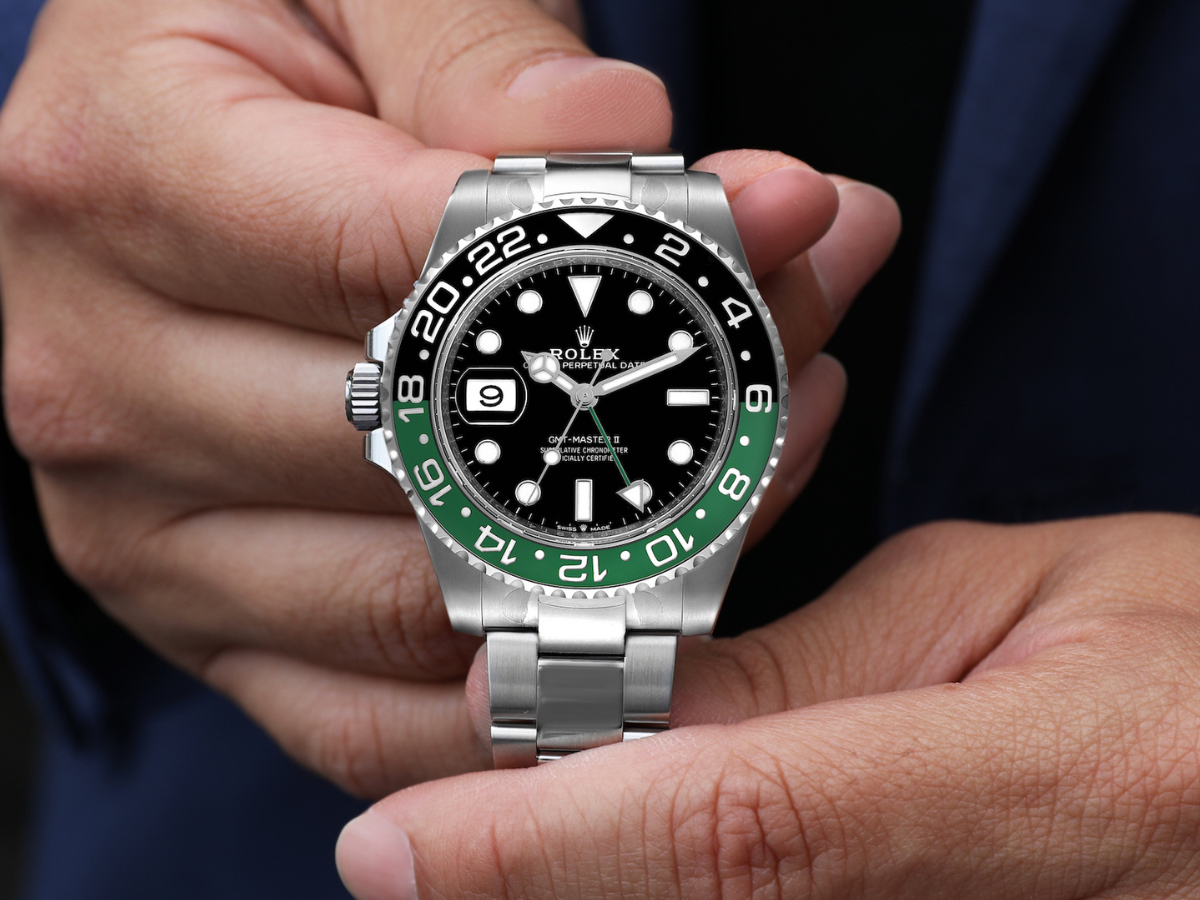
Reference 126720 VTNR (2023-Present)
The Rolex GMT-Master II Reference 126720 VTNR, affectionately nicknamed the “Sprite,” was introduced in 2022, marking a notable departure from traditional designs. This model features a left-handed crown, also known as a “destro” configuration, designed for those who prefer wearing their watch on the right wrist. This is a rarity in Rolex’s lineup and reflects their commitment to inclusivity and innovation. The 126720 VTNR sports a striking green and black Cerachrom bezel, a color combination that has quickly become iconic within the GMT-Master series.

The watch is powered by the in-house Caliber 3285 movement, which boasts a 70-hour power reserve and includes advanced features like the Parachrom hairspring and Chronergy escapement, ensuring exceptional accuracy and durability. The dial is classic black with Chromalight luminescence for excellent legibility. The date window is positioned at 9 o’clock, another unique feature of this model, further distinguishing it from other GMT-Master II references.
The 40mm case is crafted from Oystersteel, offering robustness and corrosion resistance. The 126720 VTNR is available with both Oyster and Jubilee bracelets, providing versatility in style. The introduction of this model has not only added a fresh aesthetic but also expanded the GMT-Master II’s appeal to a broader audience, making it a significant addition to Rolex’s storied collection.
<>
<>

Reference 126710 GRNR (2024-Present)
The Rolex GMT-Master II Reference 126710 GRNR, introduced in 2024, continues Rolex’s tradition of innovation with a new gray-and-black bicolor bezel made from high-tech ceramic. Dubbed the “Bruce Wayne,” this model showcases Rolex’s mastery in combining aesthetics with advanced materials. The gray and black Cerachrom bezel is not only visually striking but also offers exceptional durability and resistance to fading.
The 126710 GRNR is powered by the state-of-the-art Caliber 3285 movement, featuring a 70-hour power reserve and enhanced precision thanks to Rolex’s patented Chronergy escapement. This movement is COSC-certified, ensuring top-notch performance and reliability. The watch retains the classic 40mm Oystersteel case, known for its robustness and corrosion resistance, making it suitable for various conditions.

This model is available with both Oyster and Jubilee bracelets, each offering a distinct style and level of comfort. The Oyster bracelet lends a sportier feel, while the Jubilee bracelet adds a touch of elegance, providing versatility for different occasions. The dial features Rolex’s Chromalight display, ensuring excellent legibility in low-light conditions.
The “Bruce Wayne” GMT-Master II not only expands the aesthetic options within the series but also reinforces Rolex’s commitment to continuous improvement and innovation. This reference is a testament to Rolex’s ability to blend tradition with modern advancements, appealing to both collectors and new enthusiasts alike.
<>
Final Thoughts
The Rolex GMT-Master and GMT-Master II have cemented their status as icons in the world of horology. From their inception as tools for pilots to their current status as symbols of luxury and precision, these watches continue to captivate enthusiasts and collectors worldwide. Whether you are considering purchasing a vintage model or the latest release, understanding the rich history and key features of the GMT-Master series will undoubtedly enhance your appreciation for this legendary timepiece.
For those interested in exploring or purchasing these iconic watches, SwissWatchExpo offers a wide selection of Rolex GMT-Master and GMT-Master II models, ensuring that you find the perfect addition to your collection.
<>
The post Rolex GMT-Master Ultimate Guide appeared first on The Watch Club by SwissWatchExpo.







